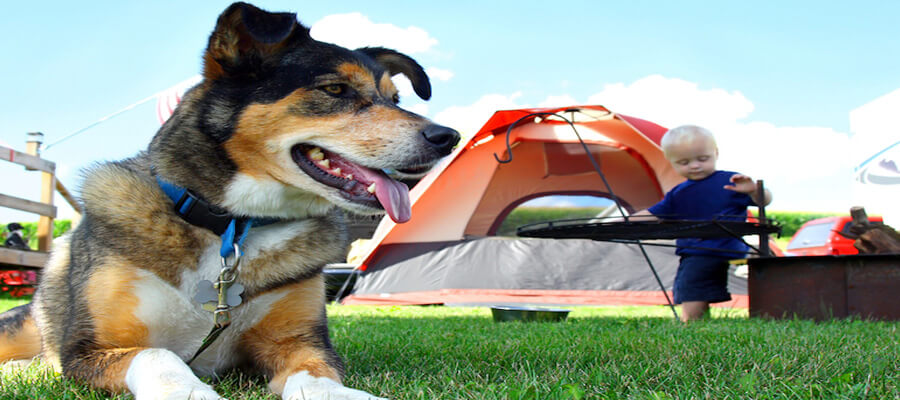
Updated on | by Critter Nets - Blogs
How to Train Your Dog for Camping Trips
Train Your Dog for Camping Trips
Camping with your dog can be one of the most rewarding outdoor experiences. But to make sure it’s both safe and enjoyable for both of you, a few preparation steps can go a long way. This guide covers everything you need to know to get your dog ready for the great outdoors, including essential commands, campsite manners, safety measures, and tips for managing unexpected challenges along the way.
1. Start with Basic Obedience Training
Before you hit the trail, make sure your dog has mastered essential obedience commands. Training your dog to respond promptly to "sit," "stay," "come," and "leave it" will ensure they listen to you in a high-stakes environment with various distractions. Consistent obedience training is a crucial first step, helping your dog become responsive even when tempted by new surroundings, animals, and smells.
2. Teach Strong Recall for Off-Leash Adventures
Essentials for Your Newly Adopted Pet
Welcoming a shelter pet into your life is a beautiful journey. Here are some handpicked items to help your new friend feel safe, loved, and right at home:
If your camping site allows dogs to roam off-leash, teaching a strong recall command is vital. Practicing the "come" command in controlled environments before your trip is essential to build a reliable response. Use treats and positive reinforcement to reward your dog whenever they return to you, even amidst distractions. Practicing in different environments will prepare your dog for diverse sights and sounds during camping.
3. Leash Training for Crowded Trails
Not all camping areas are remote; some may have trails with other hikers, families, and pets. Train your dog to walk calmly on a leash to prevent lunging or pulling, which could be dangerous on rugged terrain. Use a comfortable harness or leash that provides you with control and security. Practice leash training in busy areas to ensure your dog is used to staying calm around others.
4. Introduce Your Dog to Camping Gear
To make your dog feel comfortable with camping, let them explore the gear you’ll be bringing. Familiarize them with a dog backpack if you plan to have them carry supplies and with any tents or sleeping bags. Doing this at home helps them feel less intimidated by new items, making setup and bedtime at the campsite easier and stress-free.
5. Practice Good Camp Manners
Teaching campsite etiquette is important for a smooth camping experience. Train your dog not to beg for food, bark excessively, or invade other campers' spaces. Practicing this at home and reinforcing good behavior with positive reinforcement at the campsite will help keep the peace with nearby campers and make your time outdoors more enjoyable.
6. Train for Unexpected Noises and Sights
Camping introduces dogs to many new stimuli, including wildlife sounds and other campers. Training your dog not to react to startling sounds will keep them calm and reduce the risk of them bolting. Practice calming techniques, such as focusing exercises or gentle pressure techniques (using a Thundershirt or a snug harness) that can be soothing during sudden, unexpected noises.
7. Prepare for Wildlife Encounters
If you’re camping in areas with wildlife, training your dog to "leave it" and avoid chasing animals is essential. Reinforce this command to prevent dangerous interactions with wildlife like deer, squirrels, and even bears. Keeping your dog on a leash or within your line of sight also protects both them and the local ecosystem.
8. Teach Trail Etiquette for Hiking and Exploring
For dog-friendly trails, training your dog to walk on specific paths and respect other hikers is part of trail etiquette. Practice passing people, cyclists, and other dogs politely, either by sitting or maintaining a calm walk by your side. Teaching your dog to wait and move on command can prevent blockages and ensure a positive experience for everyone on the trail.
9. Practice First Aid Basics and Safety Commands
Knowing how to handle minor injuries like paw cuts or insect stings is vital for camping. Keep a pet first-aid kit on hand and familiarize yourself with simple care techniques. Commands like “stop” or “hold” are also useful for quick examinations or minor wound care, helping your dog stay calm in emergencies. Having a safe “stop” command can also help if they encounter dangerous plants or insects.
10. Ensure Hydration and Health Awareness
Camping often involves long hikes and hot days, so training your dog to drink water when offered can prevent dehydration. Practice offering water on walks, and if they’re hesitant, encourage drinking with rewards. Be mindful of their behavior—if they seem overheated or tired, give them breaks, and watch for signs of overexertion.
11. Plan a Comfortable Sleep Setup
Whether sharing a tent or bringing a portable crate, ensure your dog has a comfortable sleep space. Familiarize them with this sleeping setup at home so they know it’s a safe, cozy place. Dogs tend to sleep lightly outdoors, so make sure the setup is secure and near you to keep them calm during nighttime sounds.
Conclusion
Training your dog for camping takes effort and patience, but the payoff is worth it. By teaching obedience, instilling good manners, and practicing for potential wildlife encounters, you and your dog will be prepared to embrace the adventure. Whether hiking trails or relaxing at the campsite, a well-prepared dog makes camping both safe and fun, deepening the bond and creating memories that will last a lifetime
Affiliate Products
We may earn a small commission when you shop through our links — it helps us keep sharing love and care for every dog out there, at no extra cost to you.

